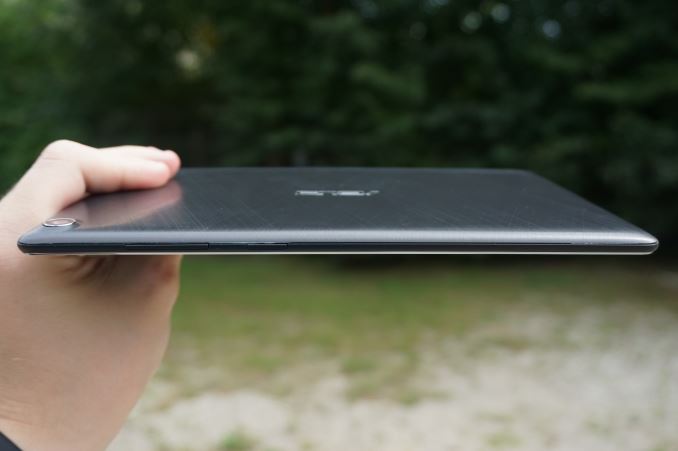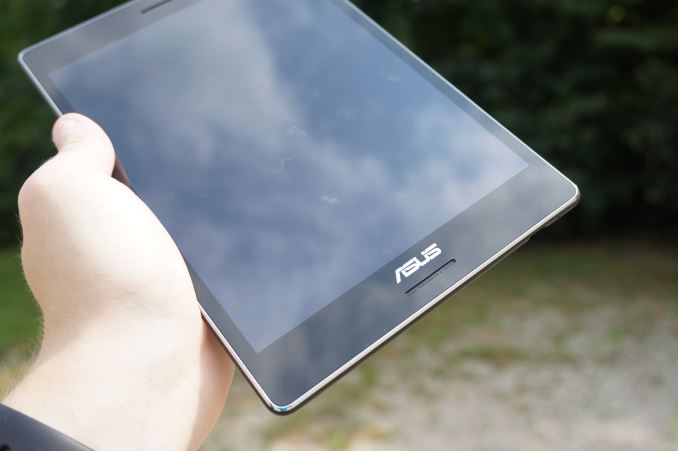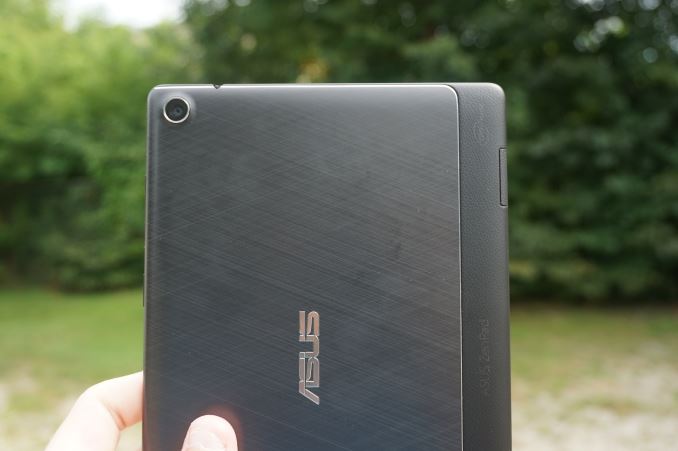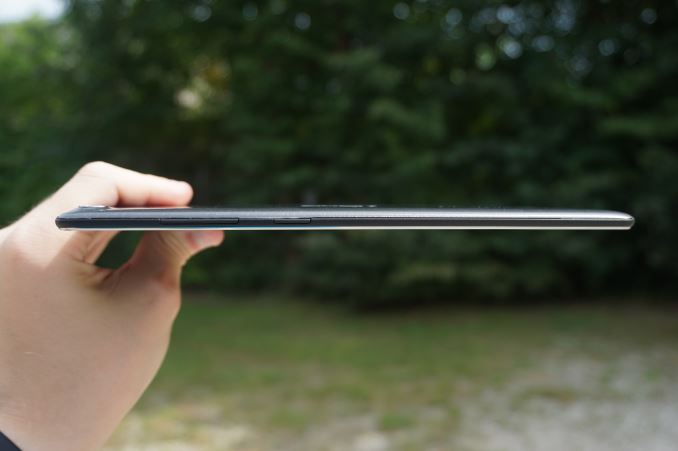The ASUS ZenPad S (Z580CA) Review
by Brandon Chester on August 31, 2015 8:00 AM ESTDesign
In my mind, I think of the ZenPad S Z580CA as a companion to the ZenFone 2. Both devices have an affordable price, and you can really buy both of them and still end up spending less than you would on a flagship smartphone. While they definitely share a UI and many internal hardware components, there isn't much similarity between the external design and construction of the two devices.
The first thing you'll notice when you pick up the ZenPad S isn't how the materials feel, but how incredibly thin and light the entire device feels. It's 6.6mm thick at its thinnest point, and the thickest point is only a small fraction of a millimeter thicker than that. Its mass is only 298g, which makes it the lightest tablet I've looked at to date. While it's not as thin as the iPad Air 2 or the Dell Venue 8 7840, the thickness and mass work together to give a feeling of lightness and portability that I've only ever experienced with one other device, which was the original iPad Mini.
There's not much to say about the front of the ZenPad S. Like all tablets, it's just a big display. ASUS has made space for two front-facing stereo speakers, which is something you won't get on an iPad or on the Galaxy Tab S2. As for the quality of the speakers, my highly subjective evaluation is that they are better than the iPad Air 2, and much better than the Nexus 9. They also don't cause significant chassis vibration despite the tablet's small thickness, which is something the iPad Air 2 suffers from.
Surrounding the edge of the ZenPad's front bezels is a metallic looking silver edge. This is really made of plastic, and like the plastic construction of the ZenFone 2 I'm a bit concerned about its durability. Readers may remember that a single fall from an extremely short height ended up scuffing up the back cover of our ZenFone 2 pretty badly. With the ZenPad S I have made sure to be quite careful, and haven't dropped it or hit it off anything to the best of my knowledge. Even so, there are some small dents in the silver edge. Pressing on it confirms that it's a fairly soft plastic, and I feel like it's going to be a magnet for these types of small dents and marks. In contrast, the Nexus 9 and iPad Air 2 testing units I have could probably be packaged and sold as brand new despite having them in my possession for significantly longer than the ZenPad S. If someone intends to use the ZenPad S as a tablet they can throw into their bag with other objects I would definitely be aware of the potential for damage to the edge.
The back of the ZenPad S is split into two sections. The smaller section has a soft touch feeling, and almost feels a bit like the pleather some phone cases are made of as it has a texture to it. This section is slightly thinner than the rest of the back cover, and it houses the tablet's MicroSD slot. What's interesting is that this part blends smoothly into the sides of the tablet, even though the sides have a distinctly different feeling due to their lack of texture. The soft touch part of the tablet also has the tablet's name and the Intel logo on it. However, it rubs off fairly easily as you can see in the image above, and at the time of writing this paragraph the logos have come off entirely.
The second part of the ZenPad back cover is a large plastic panel. In my review of the ZenFone 2 I said that the back cover of the phone did a good job of mimicking the appearance of aluminum, but felt entirely like plastic. The plastic segment of the ZenPad's back cover could actually convince you that it's made of metal unless you have the urge to tap on it. Like the ZenFone 2, the ZenPad's back cover has a shine to it that looks very much like the reflections made by brushed aluminum, although in the ZenPad's case the back cover has a pattern of overlapping diagonal lines rather than the straight lines of the ZenFone 2. Unfortunately, the hard plastic part of the back cover doesn't give any illusion of the tablet itself being made of metal, as you'll always be touching the soft touch plastic of the sides and the smaller segment of the back.
Right out of the box, my ZenPad S review unit did seem to have some issues with the hard plastic segment of the back cover that I think should have been picked up during QA. As you can see in the images above, there are areas on the edge of the plastic that are warped in such a way that they are no longer smooth like the other sections. It looks like these areas weren't finished properly, and when you look at the tablet from the side you can see that the entire edge around the power button and volume rocker is improperly formed and doesn't have the same color as the rest.
Ultimately I think the ZenPad S does a good job at being what it is, which is a tablet with a plastic chassis. My big concern is that the iPad Mini 2 sits at exactly the same price, and offers a completely aluminum chassis that feels much higher quality and will likely not incur the damage I've seen on the ZenPad's edge and back cover. The iPad is obviously heavier and thicker though, and the only way to achieve the low mass that the ZenPad S has is with plastic.
Personally, I think if I was given the choice I would opt for a slightly thicker and heavier device made of aluminum or a more durable plastic than a thinner and more easily damaged plastic one. The thicker device also has the benefit of storing a larger battery. Other people may value the thinness and the lightness more, particularly with 8" tablets which are more likely to be kept on someone's person than larger tablets. In the end everything is a series of trade-offs, and it's important to think about what aspects of design and build quality matter most to you when considering which tablets to buy.














114 Comments
View All Comments
DanNeely - Monday, August 31, 2015 - link
The "sharpening" filter that smudges text legibility is the deal breaker. Having tried using them before, I completely agree with the reviewer about how badly they suck. They might help in some circumstances; but having the opposite effect on one thing that needs legibility more than anything else makes them worse than useless as an always on feature.I still don't get what you're going on about the Samsung and $100 more. AGAIN, I don't find it too expensive compared to the Zenpad. If the Samsung didn't have retarded buttons it looks like it'd be a great device and I'd probably own one. Putting the same level of hardware in a chassis with buttons in the correct order shouldn't drive the price to $500.
MrSavage - Monday, August 31, 2015 - link
You think the Z580CA would have blurred or smudged text? I tell you this. I'm going into a store and seeing to believe. It's late 2015 and if you're telling me that a new tablet with new technology is going to have some blurry or unclear text or visuals? If this was 2012 I might buy that.Regarding Samsung and $100? Have you actually gone spec by spec to compare? Beyond that, if you put 2GB of RAM (Samsung with around 3) and the same 32GB of storage? I would bet this Z580CA would be selling for $250 or less! No front speakers, no stylus support on top of that. I think your idea of reasonable or wise differs from mine.
So you are taking a few charts on the display as being the final word? If there are any issues regarding software enhancements, I'm confident in firmware and software updates to resolve any possible issue. I have some faith in that and considering the price, it's not exactly a super risky proposition.
PixyMisa - Monday, August 31, 2015 - link
On specs, the $399 S2 is closer to the $199 Z580C. I expect the AMOLED screen will be very nice, though.A side-by-side comparison of the 8" iPad, S2, and Z580C/CA would be very interesting.
Kepe - Monday, August 31, 2015 - link
How about an HP Pro Slate 8? The only real downside seems to be the bundled pen contraption, but you don't have to use it, of course.DanNeely - Monday, August 31, 2015 - link
First I've seen it; but other than potential availability (HP doesn't have it in immediate stock, and Amazon appears to only have the Win8 model), I don't see any show stoppers in a quick look at reviews. Paying for a pen'd just end up in my junk drawer's annoying but if it's my only option...modulusshift - Monday, August 31, 2015 - link
Since I have an Air 2 running the latest iOS 9 beta, I decided to see what you meant by performance enhancements.Kraken 1.1 - 2446.3
Octane v2 - 10441
WebXPRT 2015 -
modulusshift - Monday, August 31, 2015 - link
162 was the WebXPRT score. So yeah, some improvements have definitely been made. The Air 2 now out scores every tablet score you have on that table by a significant margin.Brandon Chester - Monday, August 31, 2015 - link
Yeah that's what I meant. I will be able to update the iPad Air 2 once iOS 9 releases, but I don't have an Air or a Mini 2/3 on hand.modulusshift - Monday, August 31, 2015 - link
For fun, a MacBook Pro 13 on Yosemite:Kraken - 2013.6
Octane - 21636
WebXPRT 2015 - 320
Kepe - Monday, August 31, 2015 - link
In short: you get what you pay for. Display you have to calibrate yourself with software that makes it horrible, mediocre performance, mediocre build quality with low-quality materials, horrible camera, non-competitive battery life. But hey, at least you get front-facing stereo speakers that are ok!